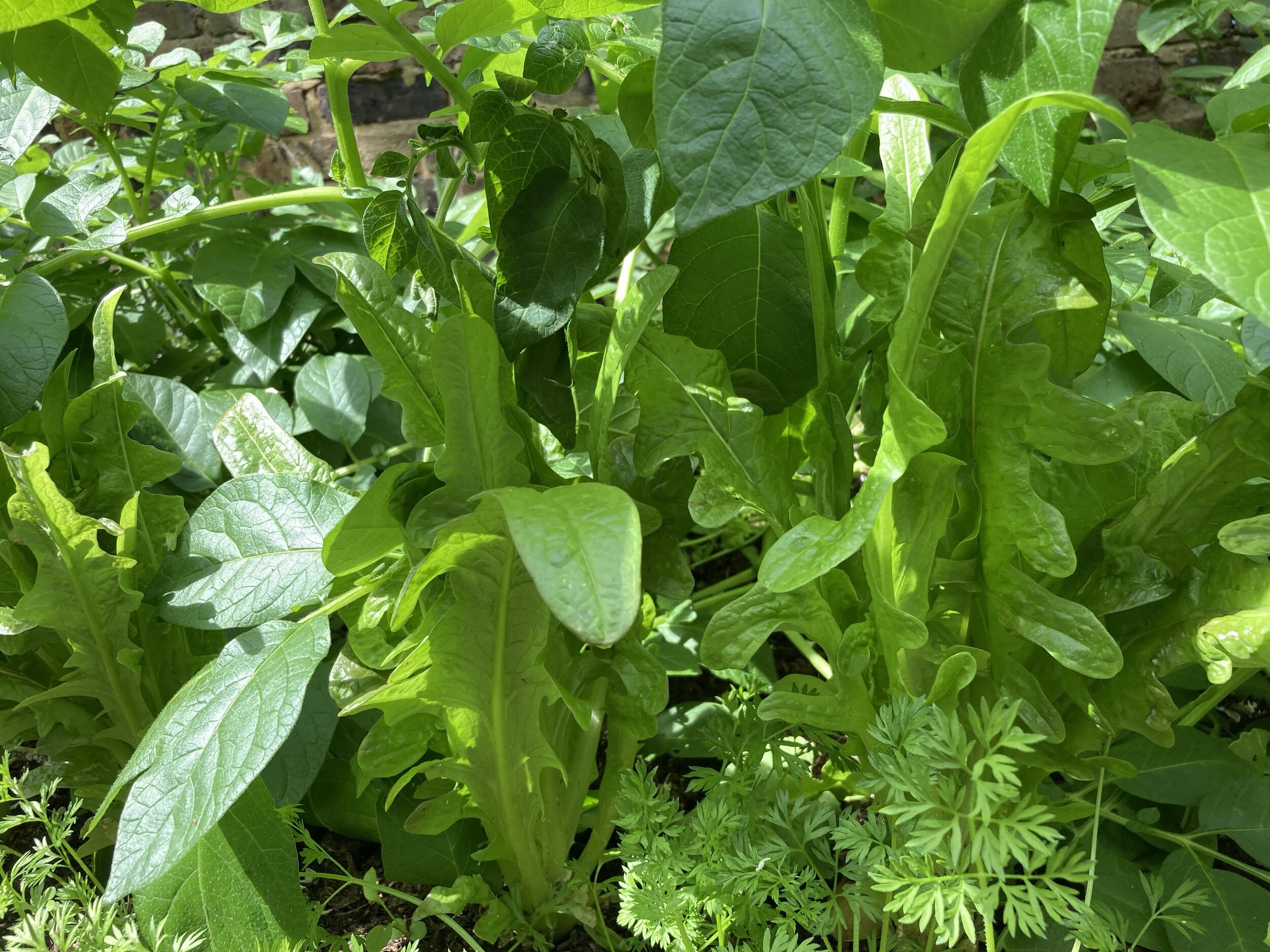Squeezing Veg into a Small Garden
Having talked about lack of sunlight in my last post, this week I am on to lack of space. One of the hardest things about having limited space is having to make painful decisions about what to grow, or rather, what not to grow. There are a few things that really do take up a lot of room, two good examples being asparagus (which are perennial and so take up a whole bed whilst only producing a brief spring harvest) and sweet corn (which in order to pollinate well need to be grown in some number in a grid formation). For everything else, there is usually some way of squeezing it in.
What do you want to achieve?
Once you’ve come to terms with the limits of your plot, I think it’s great to decide what is going to give you the most enjoyment and satisfaction in the garden. The internet is full of images of gardeners staggering under the weight of 20 cucumbers, trundling wheelbarrows of enormous squash and excitedly displaying trugs overflowing with Hungarian Hot Wax chillies. Ask yourself – what happens to the chillies after the photo shoot? Unless the gardener in question runs a curry house, they will most likely be dried or frozen. How many cucumbers do you really want to eat? Would one windowsill chilli plant be enough? I would much prefer to pick beans and courgettes every day and, aside from green leaves, would never expect to grow enough of one vegetable in a year to meet all my needs. So we have a few squash ripening, and enough tomato plants that a handful of baby tomatoes are ready to enjoy every few days, but I would never expect to be freezing garden passata and our cucumbers are a treasured treat.
Choosing repeat harvesting plants and eating as much of the plant as possible
In my quest to grow my own greens and salads for a year, I have become a huge fan of green veg that you can continually harvest. Charles Dowding grows his lettuce this way, pulling off the bottom leaves until the plants hover above the ground like a UFO on a clean stalk. I’ve loved growing lettuce this way but it’s also a really good strategy to keep in mind when choosing what to grow.
Gai Lan ready for the wok
If you choose crops that take a long time to mature for a single harvest you can be left with empty gaps while you wait, and what’s more you are putting all your eggs in one critically-timed basket. We grew cauliflower last year and waited an eternity for the heads to mature. Then in a snap of hot weather while we were away for a long weekend the heads all ‘blew’ and that was that. I can’t face waiting a long time for something which takes up a load of space and gets eaten in one evening, so instead of growing cauliflower or calabrese I would always choose sprouting broccoli, or even better spring rapini which grow incredibly fast and repeat crop. My favourite discovery this year has been ‘Wok Broc’ or Gai Lan, which is halfway between kale and tender stem broccoli. You eat the stems, leaves and flowers on new shoots, and after cutting back the main stem the plant rapidly throws out side shoots which can then be snapped off. The plants grow back repeatedly and quickly, and because you eat the delicious stems you get a substantial harvest. It doesn’t have the majesty of a full broccoli plant…but it’s a darn sight more practical.
Similarly, rather than waiting for cabbages to mature into full heads, I would always choose to grow collard greens or spring greens where you can just pull the outer leaves away and leave the plant to grow (plus I prefer them to hearting cabbages anyway).
Collard greens ‘Sweetie’ ready to pick much faster than a full cabbage
I haven’t grown peas very much because I find that they span a difficult stretch of the spring and early summer when I could be growing a lot more in the same space, but in a small garden, rather like eating the stem of Gai Lan, mange tout style crops where you eat the whole pea pod definitely make more sense than full-size peas for podding.
Planning ahead
I’ve found it really helpful to have a clear plan in mind of the year ahead and what can grow where (due to our limited sunlight). Some things like tomatoes, courgettes and beans have a fixed season and will always take up prime real estate from June/July onwards, but with a lot of other veg you can cleverly work out a schedule to be able to grow a bit of everything. For example, carrots can be sown in very early spring for an early summer harvest, or in July for an autumn harvest, so if you are happy to only grow carrots once in the year you can choose between the two. They can also be left in the ground to mature to full size, or used as baby vegetables (especially early varieties) when you need more space. We grow first early potatoes so that they take up the beds from March to June at a point where there is less pressure, and as soon as they are out, the summer veg go in. There are some useful apps that can help with planning. One word of advice – always add a few weeks to the ‘ready to harvest from…’ marking on seed packets – they are normally giving a best-case scenario or a timeframe for ‘baby veg’, so it’s worth leaving yourself some wiggle room.
Start seed in modules…
Leaving seeds to germinate in the soil can be a real waste of bed space. Worse still if, after waiting for 2 weeks, a few slugs come and demolish an entire row of small lettuce plants. Starting things in modules allows you to protect them, grow them fast, and to grow a lot of plants in a small space. If plants start to outgrow their modules, they can just be potted up, so things like tomatoes and cabbages can end up in quite big pots of their own, like an understudy waiting eagerly in the wings of the theatre, and jumping on stage as soon as an opening is available, ready to steal the show.
… or plan to eat your thinnings
The one exception to this is leafy greens. If you don’t have many seeds in a packet, you’re still better off using modules for a safe start, but I have a packet of ‘Cavolo Nero’ kale which has hundreds of seeds and realistically I have space for about 6 plants a year, so I sow the seed generously and then gradually thin out plants treating these as a planned harvest – first tiny leaves for salads, then 10cm plants as a tender leaf to cook - before the remaining plants are left to mature. This way the ground works harder for you from the get-go.
Using height
Plants that grow upwards leave the rest of the bed bare, and often don’t mind having their feet covered up anyway. Climbing beans don’t need that much space and you only need a few plants to get tonnes of beans. Plus they can grow up a fence, or in the middle of a flower border, or over a path. If you don’t have much space, don’t grow bush beans.
The famous ‘Three Sisters Bed’ combines growing sweet corn with beans weaving up the stems, and then squash shading their feet. Although we don’t grow sweetcorn we do have courgettes growing around the feet of the beans, so the bed is pretty packed.
Similarly our cucumbers and tomatoes are growing up canes along the back of a bed where they get lots of sunlight. Unlike growing them in a grid in one bed, this allows plenty to be grown in front of them as their wiry stems take up almost no space at ground level.
Squash are prohibitively expansive and can swamp a small garden, but they do really well grown up a frame (although they will still need quite a bit of floor space for the supporting structure).
Fast growing filler plants
I’ve decided that full-sized carrots just aren’t something I need to grow to feel good about the garden, and they end up taking up space for too long. ‘Early’ carrots grow quickly and can be harvested young as babies. A treat rather than a staple, you wouldn’t use them in bolognese but they’re great dipped in hummus. A few crops like radish, rocket and salad leaves are super quick filler crops which can be planted around other plants (brassicas, tomatoes etc) to get an extra harvest from the space. And pak choi have also been a real discovery for me, growing fast and good for filling a gap before the next harvest.
Containers
Turk’s Turban squash with space to sprawl on our roof
There are loads of amazing blogs and vlogs about people who grow incredible produce only using containers, and even though I have ground to grow in, I’ve been experimenting with cramming pots between raised beds and in odd places to try and get as much growing space as possible. Some plants seem to need a good root run and do best in the ground, but there are lots of things that are happy in containers and we have 3 squash plants growing in buckets on our roof and tomatoes in pots that Toby shuffles around the garden to follow the sun.
We are far from self-sufficient, but take so much pleasure from growing our own. Fitting in bits and bobs of what we enjoy most seems to create a healthy patchwork of plants that do well, even if we can’t crop rotate like the pros. I’ve been amazed at how much we can squeeze into a few raised beds and as the years go by I’m hoping I’ll get things streamlined to the point that there is always something waiting to be eaten. I’m so impressed by the amazing gardeners I see growing vegetables in the most unlikely places, and it’s exciting to see how, as a new generation of gardeners get by without allotments or a large space, our methods of growing vegetables are adapting.







